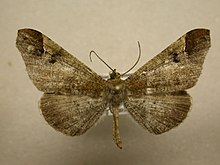|
Macrosoma bahiata
Macrosoma bahiata is a moth-like butterfly species described by Cajetan von Felder and Alois Friedrich Rogenhofer in 1875. It belongs to the family Hedylidae.[1] Originally it belonged to the genus Phellinodes. Malcolm J. Scoble combined it with Macrosoma in 1986.[2] DistributionThe species is found in East Mexico, Quintana Roo Territory through Central America to Lima, Peru. East to Belém, Bahia, Brazil at the mouth of the Amazon.[2][3] DescriptionWingsM. bahiata has wings of greyish brown ground colour. The apex of the forewing is dark brown and very weakly emarginate. Small white marks are usually merged at proximal edge of dark apical patch. And prominent, dark, postmedial spot towards middle of wing is found. GenitaliaMaleFollowing are the characteristics of the male genitalia:[3]
FemaleThe female genitalia has the following features:[3]
AntennaThe antenna is not bipectinate in both sexes.[3] DiagnosisThe prominent postmedial spot on the forewing enables M. bahiata to be get distinguished from M. uniformis, M. albistria, and M. coscoja, the species to which it looks most similar. The shape of the Gnathos is a usefully a distinguishing feature. References
Sources
|
||||||||||||||||||||||||||||||
Portal di Ensiklopedia Dunia
